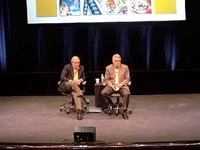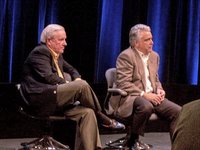On Kodak and Other Matters
Some stray thoughts from a jet-lagged mind following Kodak's meeting in New York with money managers:
- Film might be on the way out, but will still play an important role in determining the company's destiny, according to Chief Executive Officer Antonio Perez. Movie film, that is. The digital transformation of the movie business is taking much longer than expected, he said, as Hollywood seeks an effective business model. That business model has to do with determining who pays to install digital projectors into the world's movie houses, and crafting a selling point that will attract consumers. Because this is taking longer than expected, sales of film to cinematographers and movie studios will likely still provide cash that Kodak can use to invest in digital imaging. One of the most advanced film coating machines in the world (Kodak will say it is the most advanced, and who am I to question?) sits in Kodak Park. Perez says that movie film will remain an important business for at least two years, and probably logner.
- Kodak's finances have become intensely seasonal. The company generated almost a third of its revenue and almost all of its digital earnings in the final quarter of 2005. The seasonality has prompted Kodak executives to begin discussing changing the company's fiscal year. The idea: To avoid nasty year-end surprises. Perez stressed that Kodak has made no decision yet on changing the fiscal year.
- The company's entry into the inkjet printing business remains months off, but still on schedule for 2006. Perez was asked about it at the meeting, but he again declined to provide specifics about the technology. He says he doesn't want to give competitors such as Hewlett-Packard a leg up. He stressed, however, that the company has numerous options about how to participate.
- Kodak's meeting was in the Equitable Center, an office complex along 7th Avenue, about a dozen blocks from Times Square (to the left) and another half dozen or so blocks to Central Park (to the right.) Kodak uses the Equitable Center because of its extensive audiovisual facilities in the basement auditorium. It was unseasonably warm -- in the high 50s and low 60s most of Sunday and Monday.
- Witnessed an interesting photographic moment Monday night in the Hard Rock Cafe, where I ate dinner. Two young couples took the table next to me. It was clear they were tourists. Anyway, three of the four of them proceeded to take out their digital cameras, turn them on and start handing them back and forth to view images on the LCD screens. This is the epitome of the challenge for Kodak and the photo industry: Reaching these young people and convincing them to make prints of their images as well as sharing them electronically.
- Here's a link to a hometown story about Mary Jane Hellyar, a long-time Kodak executive who now manages Kodak's film and photofinishing services business. Hellyar went back and spoke to her school in Fairmount, Minn. recently.
- Finally, Jerry O'Neill, a local freelance writer for various photo industry publications, sent along edited versions of my photos from the investor meeting. I am reposting below, just to show what is capable in digital imaging today.. Jerry used Kodak-owned software technology to enhance the images.
 Weather
Weather Local News
Local News



1 Comments:
StellarTech,
Funny thing is, the connected digital picture frame is an idea that's been around for at least seven years. Kodak tried it themselves a few years back. And yet, the latest figures indicate that this year will see 25 billion digital images get turned into hardcopy. Projections call for that growing to 30 billion in two years. I absolutely agree with you that there is a generational gap that the photo industry has to deal with. But I think history shows that there is no one single "consumer." There are people with many different habits and probably room for both approaches -- hard and soft copy.
Post a Comment
<< Home